Bérismenil – 13/04/1944 – B17 42-97124
Bérismenil – 13/04/1944 – B17 42-97124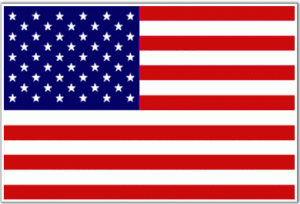
L’équipage/The crew : 2nd Lieutenant Herbert T. Swanson, pilot and aircraft commander,
2nd Lieutenant Donald O. Smith, co-pilot,
2nd Lieutenant Austin W. Dunning, bombardier,
2nd Lieutenant Charles O. White, navigator,
Staff Sergeant James H. Young, top turret,
Staff Sergeant Clarence M. Wieseckel, radio-operator,
Sergeant Ralph W. Sack, right waist gunner,
Sergeant Gordon W. McIntosh, ball turret gunner,
Sergeant Edward F. Zabinski, tail gunner,
Sergeant Donald M. Brown, left waist gunner.
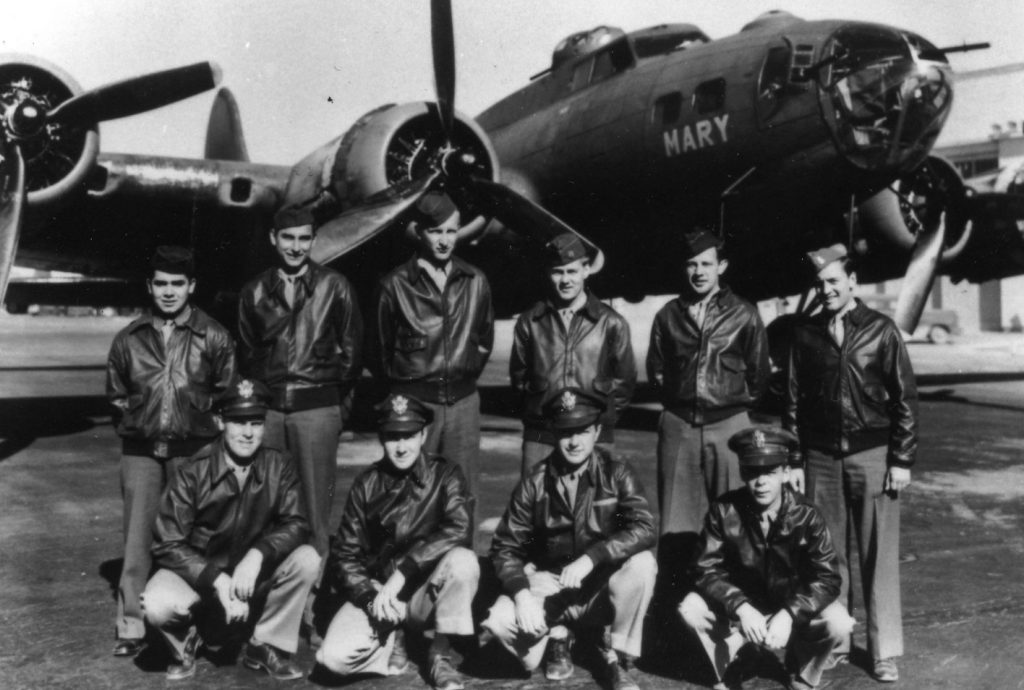
Le 13 avril 1944, la 8è Force Aérienne bombarda les usines de roulements à billes de Schweinfurt quelques minutes après l’attaque de la Luftwaffe sur la formation sans escorte. A bord du « Joker », le Sgt James H. Young, mitrailleur, fut tué par un obus de 30 mm. L’avion était en perdition, alors les aviateurs sautèrent entre Vielsalm et Bérismenil. Entendant un avion volant à basse altitude, les villageois de Bérismenil sortirent pour voir ce qui se passait. Trois parachutes dérivaient dans le ciel. « The Joker » heurta la colline “Les Crestelles” vers 15.00 hr et le feu se propagea à toute la colline. Arrivés aux Crestelles, le bourgmestre, Joseph Mottet, et les villageois cherchèrent d’éventuels survivants mais ne trouvèrent que le corps carbonisé de James Young. D’autres villageois s’employèrent à éteindre l’incendie.
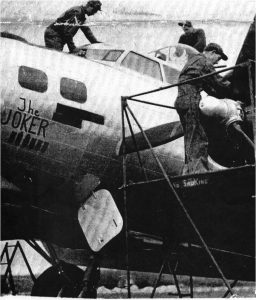
On 13 April 1944, the 8th Air Force bombed the ball bearing manufactories at Schweinfurt few minutes after the attack by the Luftwaffe on the formation without escort. On board of « The Joker », the Technical-Sergeant James H. Young, got killed by a 30 mm ammunition. The aircraft was so damaged that the crew bailed out between Vielsalm and Bérismenil (both places are located in Belgium). Hearing a low-flying B-17, the villagers of Bérismenil went out to see what was happening. Three parachutes were drifting in the sky. The aircraft slammed into the hill nicknamed « The Crestelles » around 15.00 hr and the fire set up the entire hill. The Mayor, Joseph Mottet, and the villagers searched for survivors but only found the burned body of James Young. Others villagers helped to put out the fire.
James H. Young fut enterré par les Allemands près de Florennes. Après la guerre, son corps fut transféré au cimetière militaire américain de Saint-Avold, France, et son nom gravé sur le monument aux morts de la deuxième guerre mondiale.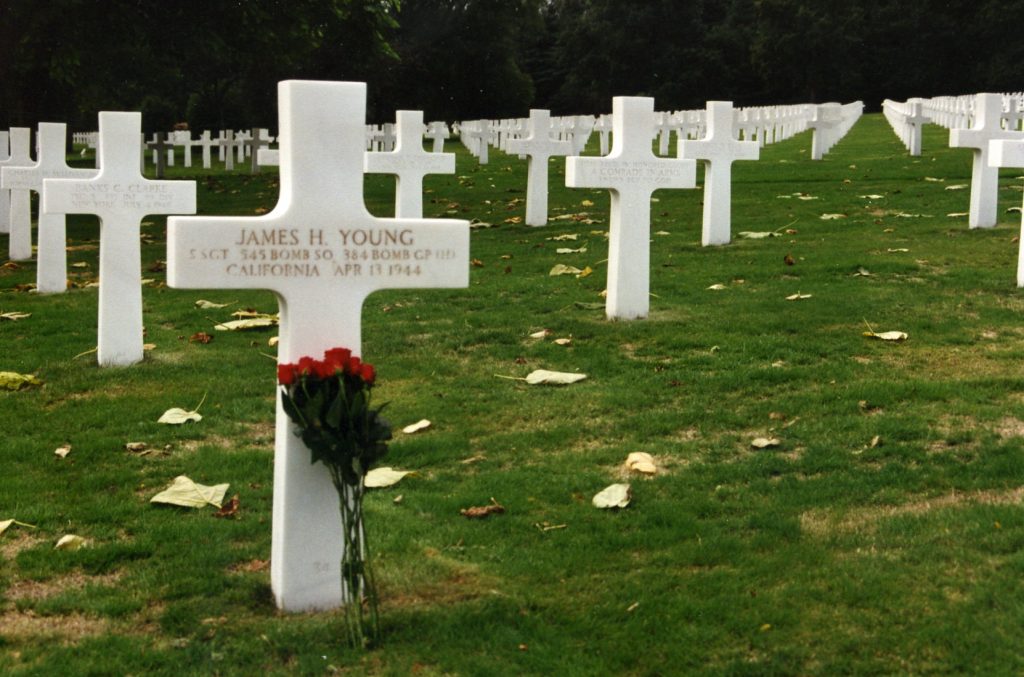
James H. Young was buried by the Germans near Florennes, Belgium against the will of the villagers of Bérismenil who wanted to bury him in the local cemetery. After the war, his body was transferred at the American cemetery at St Avold, France and its name was engraved on the memorial of the Second World War from Bérismenil.
Le S.Lt Herbert T. Swanson, pilote et commandant de bord, contacta la Résistance près de Bellevaux qui lui ordonna de prendre le train direction l’Espagne avec trois autres aviateurs. Ils furent arrêtés par les Allemands près de Tarbes le 12 mai. Arrivé en octobre 1944 au Stalag I Barth, situé sur la Mer Baltique, Herbert Swanson fut libéré le 2 mai 1945 par des Cosaques. Il fut rapatrié ce même mois aux USA.
2nd Lieutenant Herbert T. Swanson, pilot and aircraft commander, got into contact with the Resistance at Bellevaux, Belgium. He was ordered to take the train direction Spain with three other airmen. They got arrested by German nearby Tarbes (Pyrénées Mountains, France) on 12 May 1944. He arrived in October 1944 at the Stalag I Barth, located on the Baltic Sea and was liberated on 1 May 1945 by a Cossack group.
Les Sgts Ralph W. Sack, Gordon W. McIntosh, Edward F. Zabinski et Donald M. Brown, mitrailleurs, le S.Lt Austin W. Dunning, bombardier et le S.Lt Charles O. White, navigateur, recueillis par Herman Bodson et son équipe du Groupe E du service de Hotton, furent cachés dans une hutte dans le Bois de Ronce, près de Salmchâteau. Un autre rescapé, le Sgt Jim Butler arriva en même temps. Un peu plus tard le groupe se rendit à la ferme et scierie de Léon Sadzot à Forge-à-la-Plez (Dochamps). Mi-mai, le groupe se scinda en trois équipes.
The Sergeants Ralph W. Sack, Gordon W. McIntosh, Edward F. Zabinski et Donald M. Brown, gunners, the 2nd Lt Austin W. Dunning, bombardier and the 2nd Lt Charles O. White, navigator were found by Herman Bodson and his team of the Group E of Hotton’ service. They got hit in a cabin in the Bois de Ronce, nearby Salmchâteau, Belgium. Another airman, Sergeant Jim Butler (B24), arrived at the same time. Mid-May 1944, the group went to the farm and sawmill of Léon Sadzot at La Forge-à-la-Plez (Dochamps) where they stayed for two weeks. Later, the group splitted in three teams.
Ralph W. Sack, Gordon W. McIntosh, Edward F. Zabinski et Jim Butler, sur ordre de la résistance, allèrent à Sachy, France, pour être emballés dans des boîtes et transportés par train en Suisse. Lors de la traversée de la forêt de Carignan, ils entendirent des Allemands à leur recherche. Le 18 juin 1944, encerclés par ces derniers, les Américains se rendirent. C’était la fin de 66 jours avec la Résistance, à moins de 200 mètres du train ! Ils arrivèrent le 30 juin 1944 au Stalag Luft IV de Grosstychow en Pologne. Le 6 février 1945, les Soviétiques s’approchant, les prisonniers valides rejoignirent à pied le Stalag X1B à Fallingsbostel (Hanovre). Le 8 avril 1945, Ralph Sack et ses compagnons s’échappèrent. Une unité de reconnaissance britannique les libéra près de Killitz. Ils retournèrent aux USA peu après.
Ralph W. Sack, Gordon W. McIntosh, Edward F. Zabinski and Jim Butler, upon order of the resistance, went to Sachy, France, to be packed in boxes and be transported by train to Switzerland. During the crossing of the Forrest of Carignan, they heard Germans searching for them. On 18 June 1944, surrounded by them, they gave themselves up. It was the end of 66 days with the Resistance, less than 200 meters from the train. They arrived on 30 June 1944 at Stalag Luft IV at Grosstychow in Poland. On 6 February 1945, because of approaching Soviet forces, valid prisoners were marched west to Stalag X1B Fallingsbostel, north of Hannover, Germany. On 8 April 1945, Ralph Sack and his friends ran away. They were liberated by a British reconnaissance unit near Killitz.
Donald M. Brown et O. Charles White allèrent en France puis à Lacuisine, en Belgique. Ils prirent un train pour Bruxelles. De là, des résistants les amenèrent à Anvers le 29 juin d’où ils seraient transférés à Cherbourg, région reconquise par les forces alliées. Malheureusement les deux aviateurs furent conduits dans une prison allemande ! 77 jours s’étaient déroulés depuis la chute de leur appareil, le groupe de résistance avait été infiltré ou créé par les Allemands! Charles White fut envoyé au Stalag Luft III Sagan en Allemagne et en janvier 1945, au Stalag VIIa à Moosburg. Il fut libéré le 29 avril 1945. Donald Brown retrouva ses amis à Grosstychow. Blessé au pied, Donald Brown quitta le Stalag en train et arriva le 7 février au Stalag Luft I à Barth. Il fut libéré le 2 mai 1945. Ils furent rapatriés ensuite aux USA.
Donald M. Brown and Charles O. White went to France than to Lacuisine, Belgium. Upon order of the resistance, they took a train to Bruxelles. From there, resistant members brought them to Antwerp on 29 June from where they would be transferred to Cherbourg, France, area freed back by the allied forces. Unfortunately the two airmen were driven to a German jail ! 77 days after the crash. The two Americans have been taken in charge by a group of Resistance infiltrated or created by the Germans ! Charles White was sent to Stalag Luft III at Sagan, then to Stalag VIIa at Moosburg, Germany. He was liberated on 29 April 1945. Donald Brown went to Stalag Luft IV at Grosstychow. On the morning of 29 January 1945, the prisoners were marshalled out of the camp. Because of problems with his feet, Sergeant Brown was allowed to board a train. They arrived at Stalag Luft I at Barth on 7 February 1945, and was liberated on 2 May 1945.
Austin W. Dunning tenta sa chance vers la Suisse à pied avec un autre aviateur. Les deux Américains furent arrêtés deux jours plus tard. Austin Dunning arriva au Stalag Luft I à Barth le 4 octobre 1944. Libéré le 2 mai 1945, il fut rapatrié rapidement aux USA.
Austin W. Dunning tried to reach Switzerland with another airman. But both got arrested two days later. Austin Dunning arrived at the Stalag Luft I at Barth on 4 October 1944. He was liberated on 2 May 1945.
Le SLt Donald O. Smith, copilote, atterrit près de La Roche-en-Ardenne. Il fut hébergé par Victor Selek qui fit prévenir le bourgmestre Mottet de sa présence. La nuit venue, l’aviateur et Mr Mottet partirent à moto à Dochamps, de là dans un abri dans les bois. Puis il arriva à Sugny où il resta plusieurs semaines. Un Français lui fit traverser la frontière française. De Sedan, ils prirent le train pour Nancy. Il continua seul jusqu’à Montbéliard. Le 1 juin 1944, un contrebandier lui fit franchir la frontière suisse. Il était libre ! Il se rendit à la police et fut logé dans un hôtel de Glion. Fin août 1944, Donald Smith fut rapatrié aux USA.
2nd Lt Donald O. Smith, copilot, landed nearby La Roche-en-Ardenne. He stayed with Victor Selek who notified the Mayor Mottet of its presence. When the night came, the aviator and the Mayor went by bike to Dochamps. He was then escorted to a cabin in the woods. Few days later, he continued his trip towards Sugny (Belgium), where he stayed several weeks. Then, he crossed the Belgian-French border with a teacher. From Sedan (France), they took a train to reach Nancy. Donald Smith continued alone his trip towards Switzerland. On 1 June 1944, a smuggler escorted him till a fence separating France from Switzerland. The American crawled under it. He was free. He went to the police. After the usual investigations, he stayed at Glion in a hotel for few months.
Le Sgt Clarence M. Wieseckel, opérateur-radio, atterrit près de Bovigny. Il rejoignit un groupe de Partisans. Début mai, Clarence Wieseckel et le Lt Donald Toye, pilote abattu, partirent vers la Suisse et arrivèrent avec leurs passeurs le 31 mai dans une clairière à la frontière. Franchissant seuls les derniers mètres, il entendirent un : « halt! » suivi d’un tir de mitraillette et s’enfuirent. Par après, les fugitifs traversèrent la clairière sans la moindre difficulté. Libres, ils se rendirent à la police. Ils furent logés dans un hôtel de Glion où ils retrouvèrent D. Smith. En août 1944, il rentra aux USA.
Staff Sergeant Clarence M. Wieseckel, radio-operator, landed near Bovigny, Belgium. On 21 April, he joined a group of « Partisans ». Early May, Clarence Wieseckel and 2nd Lt Donald Toye (B24, same crew than Jim Butler), shot down pilot, went to Switzerland. On 31 May, both Americans and theirs escape agents arrived in a clearing, in front of them, Switzerland. The Americans had to go to the other side by themselves. They heard a : « Halt » followed by a machine gun shooting. Later they carefully cross the clearing. They were free. At Damvant, they went to the police station. After many investigations, Clarence Wieseckel got a room in a hotel at Glion where he found Donald Smith. In August 1944, he went back to the USA.
As mayor, Mr. Mottet had two choices to make. His first responsibility was to fight the fire in the woods. His second choice, as a human being, was more important : to make sure the survivors were gathered together and given to the Belgian resistance, who would help them through Belgium and France towards Switzerland and Spain.
Mr. Mottet found Staff Sergeant Young’s wallet and two slightly burned silk maps. As it was dangerous to keep such items, he destroyed the wallet two days later. To this day, the two maps are still in the hands of the Mottet family.
On 15 April 1944, a cross was placed exactly on the spot where the body was found.
The mayor and the villagers coordinated with the resistance to search for the American aviators and take them to a secure place.
When the Germans arrived at the crash site, they inspected the wreck where James Young’ body rested. A soldier noticed an open parachute in the nearby trees. He questioned the mayor who told him that “he did not know what was attached to it. It is not his problem, his was to fight the fire and save the wood from destruction”. Later, the Germans interrogated Mr. Mottet a second time for a long period of time and once again he acted innocent. Finally they believed that he did not know something about the crewmen.
Before the arrival of the Germans, part of one propellers has been hidden in a barn owned by François Henrard, villager of Bérismenil, with the objective to use it to build up a memorial after the end of the war.
December 1944, it is the battle of the Bulge and as there is less straw in the barn and knowing that the Nazis would murder whoever would be in possession of an allied flag, it was decided to move it again. It was transported and buried in a cave nearby the farm Henrard.

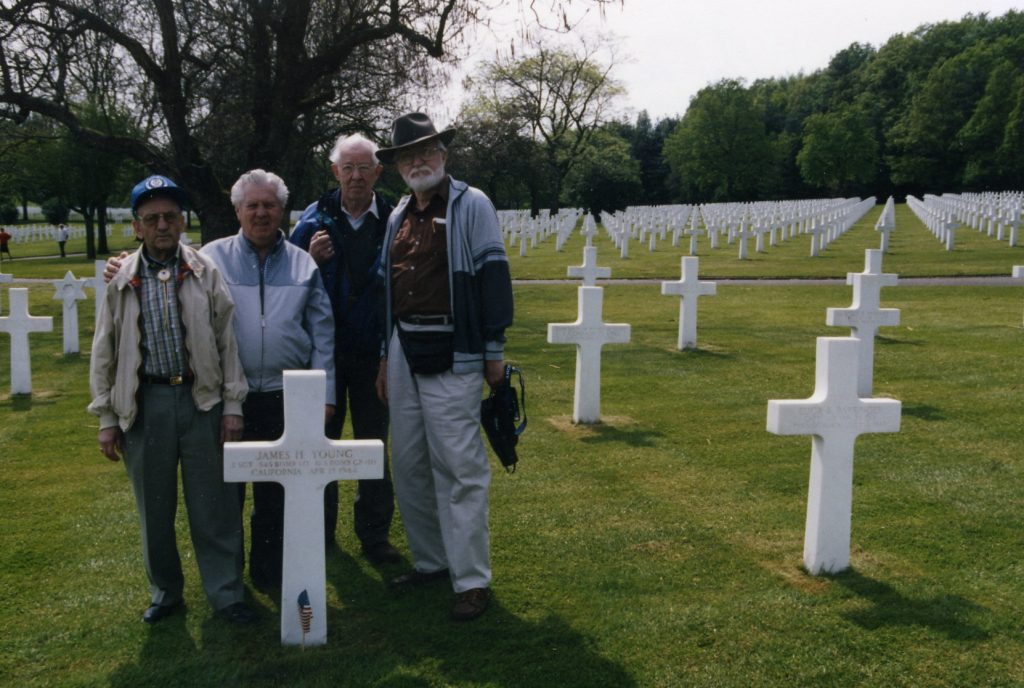
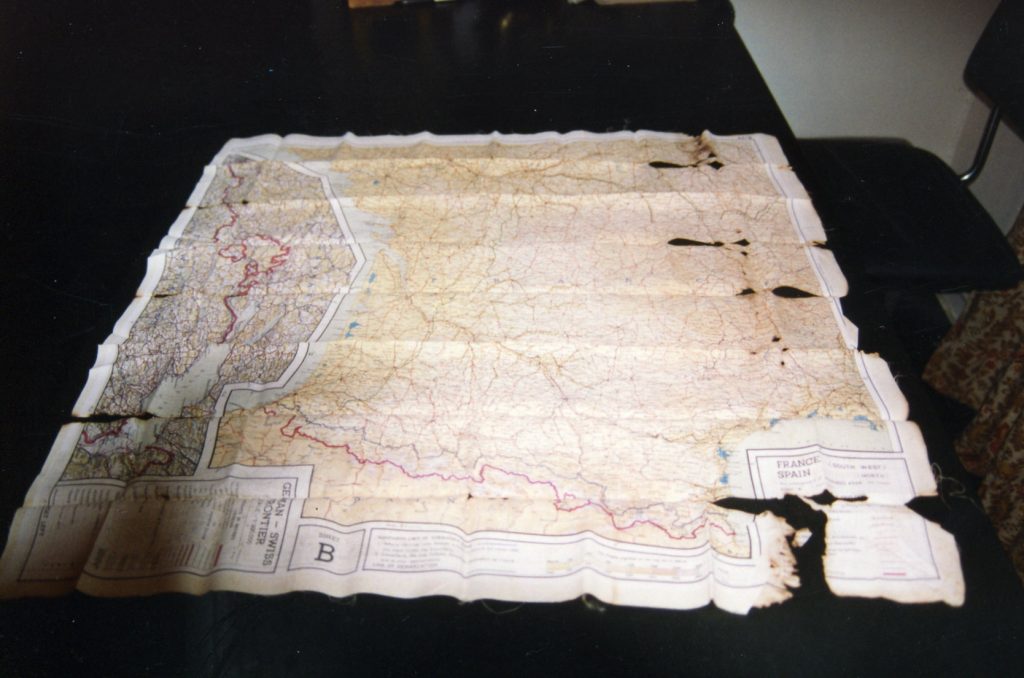
Par/ By Isabelle Engels